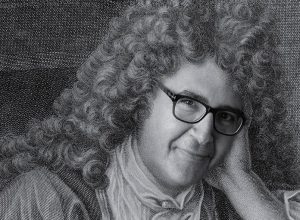
Although it is now a long time ago, Máximo Pradera was famous at the turn of the millennium as co-host, together with Fernando Schwartz, of the TV show Lo+Plus. The two of them made a good pair, with an appropriate distribution of roles between a young and pedantic Pradera and a friendly and mature Schwartz, to which the fragmentary presence of Ana García Siñeriz added some salt and pepper. The success of the show led Pradera to sign up with Antena 3 to star in a solo late night show which was a ratings disaster and was cancelled a few weeks after its premiere.
Seeing Pradera’s role in Lo+Plus and his penchant for histrionics, many were surprised to learn that Pradera was a true expert in classical music. In fact, he alternated Lo+Plus with Ciclos on SinfoRadio, a show with monographs on composers, orchestras or conductors. Pradera has published several music popularisation books, De qué me suena eso —Where did I hear that– (2005) and, more recently, Tócala otra vez, Bach —Play it again, Bach— (2016), both published by Malpaso. It is the latter that I wanted to talk about here. The reason is the presence, mostly implicit, of mathematics in several parts of the book.
In my opinion, the 35 essays that make up the book are somewhat irregular, and the insistence on how to use them to flirt, very typical of the author’s histrionics, is somewhat tiresome and insubstantial. This does not detract from the fact that Pradera, with an undeniable ability to disseminate, tackles difficult subjects that have to do with the construction of melody, harmony and rhythm in a musical composition and its capacity to affect the listener’s feelings. The mixture of these elements of music theory together with a very good choice of stories and anecdotes about musicians and composers – some of them quite erudite – means that more than a few parts of this popular book reach a degree of sophistication and depth that is to be welcomed.
And mathematics? For a book that does not shy away from questions of music theory, it would be difficult for mathematics not to be present — remember Leibniz’s famous quote: “Music is an unconscious arithmetical exercise in which the mind does not know that it is calculating” –Music and Arithmetics–.
And mathematics is present in Pradera’s book. A few times explicitly, as in chapter 20. There Pradera recalls the scene in the film Play it again, Sam (1972), where Woody Allen asks Diana Keaton which record is better to put on the record player to pick up a girl: one by the jazz pianist Oscar Peterson or the Quartet number 5 by the Hungarian composer Bela Bartók. Keaton’s response is: “Play Oscar Peterson, but leave the Bartók record in plain sight so she can see you’ve got it”. Pradera agrees with Keaton because: “Bartók’s music is enormously cerebral and mathematical”, capable of generating sombre and disturbing atmospheres far removed from the intimacy and warmth more conducive to flirtation. And he adds the following advice: “If you want to impress your partner on the first date with a very pedantic comment on the Hungarian composer, you can say:
-I love Bartók! His chromatic system is based on the laws of the golden ratio and especially on the Fibonacci number series”.
But mathematics implicitly pervades other parts of the book, without even being mentioned, and in a deeper and more significant way than the pedantic mention of the golden ratio or the Fibonacci sequence. For example, when explaining the question of harmonics and their capacity to modify the listener’s mood: “The strings of a piano or a guitar (or the air columns of a clarinet or a saxophone) vibrate as a whole,” writes Pradera in chapter 2, “but simultaneously so do their proportional parts, which can be expressed as fractions or quotients of the unit. That unity provides the audible timbre of the sound, and the fractions give rise to the complementary harmonics: second, third, fourth, and so on. When I press the middle C key on the piano, the string begins to move at a frequency of 261,626 Hertz (vibrations per second). While the string vibrates as a whole, its two halves also vibrate (at twice the speed) producing underneath a faint sound called the octave harmonic (the eight-degree interval between two notes). The fifth harmonic is the most important of the series: it is called the major third and is crucial to understanding the major and minor modes, which is the equivalent of understanding why there is happy music and sad music”.
In mathematical language, the harmonics correspond to the Fourier coefficients, which allow us to express a function defined in the interval \([0,1]\) as a series of sines and cosines of angles multiples of \(2\pi\). If we consider only sines we would have, under certain not too demanding assumptions, that
$$ f(x)=\sum_{n=1}^\infty a_n{\rm sen} (2\pi nx) $$
where
$$a_n=\int_0^{2\pi}f(x){\rm sen} (2\pi nx)dx.$$
The fundamental harmonic would correspond to the first Fourier coefficient \(a_1\), while the second, third, etcetera, would correspond to the following Fourier coefficients \(a_2, a_3, \ldots \)
It was precisely the Fourier series that appeared with the study of the problem of the vibrating string by Euler, D’Alembert, Daniel Bernoulli and other mathematicians of the 18th century. The connection of the Fourier coefficients with the vibration of the strings of a violin, for example, comes from the beginning, however surprising it may seem, as can be deduced from what is explained in Pradera’s quote, that the relationship between them comes to explain the capacity of emotional transformation that music has on the listeners.

Leave a Reply